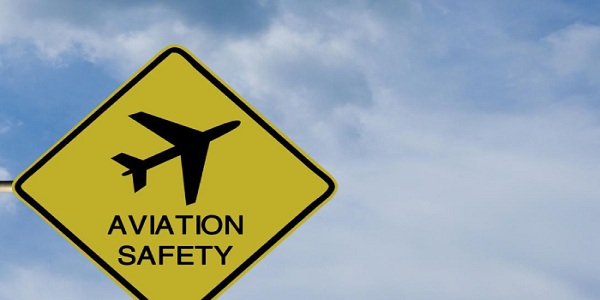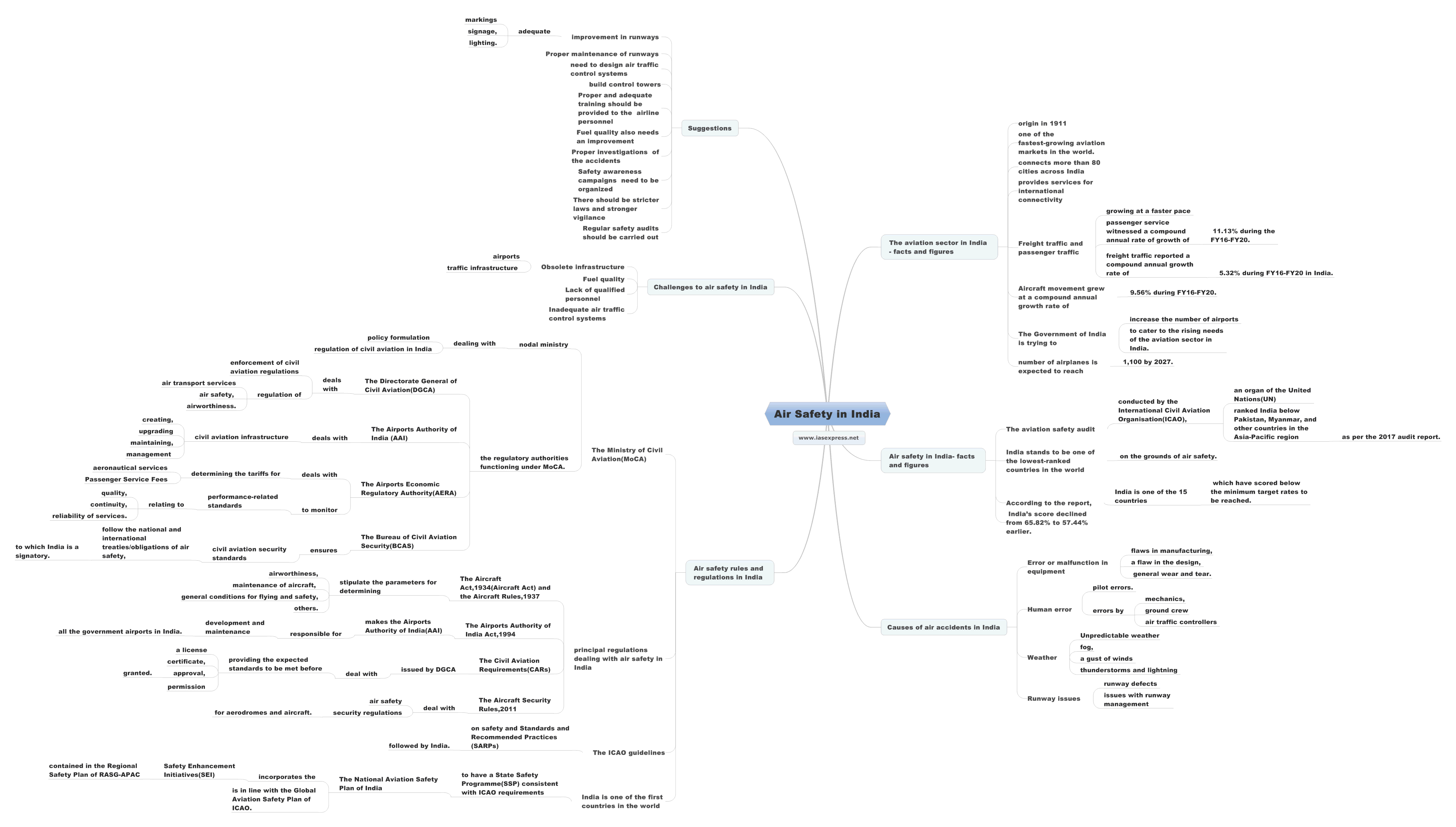Air safety in India – challenges and way forward.

The aviation sector in India has witnessed growth faster than many other industries in India. From the number of flights flying in India to the number of passengers boarding flights in India, India reported exponential growth in this sector. India has become the third-largest domestic aviation market in the world. Although the aviation market is showing promising results, the rise in the number of accidents has also risen gradually. The recent air accident in Kerala of Boeing 737, killing 18 people and leaving more than 150 people injured has been a major setback for the aviation sector in India. Thus, it has become important to understand the various factors affecting air safety in India and suggest measures to deal with the problem.
The aviation sector in India – facts and figures
- The Indian civil aviation sector has its origin in 1911 and is one of the fastest-growing aviation markets in the world.
- The Indian aviation sector connects more than 80 cities across India and provides services for international connectivity by joining with several foreign airlines.
- Freight traffic and passenger traffic, both are growing at a faster pace in India.
- The Indian air passenger service witnessed a compound annual rate of growth of 11.13% during the FY16-FY20.
- The freight traffic reported a compound annual growth rate of 5.32% during FY16-FY20 in India.
- Aircraft movement grew at a compound annual growth rate of 9.56% during FY16-FY20.
- The Government of India is trying to increase the number of airports to cater to the rising needs of the aviation sector in India.
- The number of airplanes in India has also been rising due to the rising demand. The number of airplanes is expected to reach 1,100 by 2027.
Air safety in India- facts and figures
- The aviation safety audit conducted by the International Civil Aviation Organisation(ICAO), an organ of the United Nations(UN) ranked India below Pakistan, Myanmar, and other countries in the Asia-Pacific region as per the 2017 audit report.
- India stands to be one of the lowest-ranked countries in the world on the grounds of air safety.
- According to the report, India is one of the 15 countries which have scored below the minimum target rates to be reached.
- As per the report, India’s score declined from 65.82% to 57.44% earlier.
Causes of air accidents in India
- Error or malfunction in equipment– A problem in air equipment or malfunction is one of the major causes of air accidents. The defects can be due to flaws in manufacturing, a flaw in the design, or general wear and tear.
- Human error- A number of professionals play a key role in the maintenance and safe operation of a flight. In India, it has been noticed that the majority of air accidents take place due to pilot errors. Professionals like mechanics, ground crew, air traffic controllers also commit errors that lead to accidents.
- Weather – Weather also plays a major role in the safe operation of a flight. Unpredictable weather, fog, a gust of winds and, thunderstorms and lightning affect the flight functioning and sometimes lead to accidents.
- Runway issues – There have been a number of issues with runway management in India. A number of accidents take place due to runway defects like littered debris, buckled runways, etc.
Air safety rules and regulations in India
- The Ministry of Civil Aviation(MoCA) is the nodal ministry dealing with policy formulation and regulation of civil aviation in India. The following are the regulatory authorities functioning under MoCA.
- The Directorate General of Civil Aviation(DGCA) is the agency dealing with the enforcement of civil aviation regulations and regulation of air transport services, air safety, and airworthiness.
- The Airports Authority of India (AAI) deals with creating, upgrading, maintaining, and management of civil aviation infrastructure both on the ground and in the air space of India.
- The Airports Economic Regulatory Authority(AERA) deals with determining the tariffs for aeronautical services and Passenger Service Fees to monitor performance-related standards relating to quality, continuity, and reliability of services.
- The Bureau of Civil Aviation Security(BCAS) ensures that civil aviation security standards follow the national and international treaties/obligations of air safety, to which India is a signatory.
- The principal regulations dealing with air safety in India are:
- The Aircraft Act,1934(Aircraft Act) and the Aircraft Rules,1937 stipulate the parameters for determining airworthiness, maintenance of aircraft, general conditions for flying and safety, and others.
- The Airports Authority of India Act,1994 makes the Airports Authority of India(AAI) responsible for the development and maintenance of all the government airports in India.
- The Civil Aviation Requirements(CARs) issued by DGCA deal with providing the expected standards to be met before a license, certificate, approval, or permission is granted.
- The Aircraft Security Rules,2011 deal with the air safety and security regulations for aerodromes and aircraft.
- The ICAO guidelines on safety and Standards and Recommended Practices (SARPs) are followed by India.
- India is one of the first countries in the world to have a State Safety Programme(SSP) consistent with ICAO requirements. The National Aviation Safety Plan of India incorporates the Safety Enhancement Initiatives(SEI) contained in the Regional Safety Plan of RASG-APAC and is in line with the Global Aviation Safety Plan of ICAO.
Challenges to air safety in India
- Obsolete infrastructure in terms of airports and traffic infrastructure is a major challenge to air safety in India
- Fuel quality is another issue.
- Lack of qualified personnel is one of the major challenges air safety in India is facing.
- Inadequate air traffic control systems are also hampering air safety in India.
Suggestions
- There should be an improvement in runways by providing adequate markings, signage, and lighting.
- Proper maintenance of runways is another area that needs to be focused on.
- There is a need to design air traffic control systems and build control towers.
- Revenues from air transport services should be used to update air infrastructure.
- Proper and adequate training should be provided to the personnel involved in the airline sector in India.
- Fuel quality also needs an improvement.
- Proper investigations should be carried out to find out the main reason behind aircraft mishaps so that preventive measures can be taken.
- Safety awareness campaigns should be organized from time to time.
- There should be stricter laws and stronger vigilance to deal with flight safety in India.
- Regular safety audits should be carried out of various airports and flights.
Way forward
Aviation safety in India is becoming a burning issue. When air transport is considered to be the fastest and safest way to travel, it is high time that the government invests more in improving this infrastructure and working towards its safety. There need to be more safety measures in place. Although the aviation sector and its safety in India is improving, yet a lot of things need to be done. Experienced candidates should be allowed only to operate aircraft and operations need to be carried out carefully. Safety should be given more priority over commercial reasons. People with technical backgrounds and knowledge should be appointed as the main functionaries of the regulatory bodies. Enforcement of the existing regulatory laws is another aspect that needs to be looked into. With proper management, air safety in India can be improved in an efficient manner. It is time that India’s aviation sector takes safety as a serious issue and takes adequate measures to ensure the safety of passengers and airlines.
Practise question
- Discuss various issues that are plaguing air safety in India and suggest appropriate measures to deal with the problem.
- https://www.thehindu.com/news/national/concern-over-indias-low-air-safety-oversight-score/article25099030.ece
- https://flightsafety.org/asw-article/aviation-safety-in-india/
- https://economictimes.indiatimes.com/industry/transportation/airlines-/-aviation/india-falls-below-myanmar-nepal-pakistan-in-air-safety-audit/articleshow/65945649.cms?from=mdr
- https://www.statista.com/topics/3016/air-carrier-market-in-india/
- https://www.researchgate.net/topic/Aviation-Safety
- https://www.ibef.org/industry/indian-aviation.aspx
If you like this post, please share your feedback in the comments section below so that we will upload more posts like this.



Thank you #IAS EXPRESS for such an organized article for the aspirent
You are the only one to cover air space security and many more other topics till date